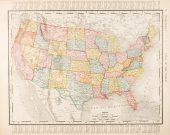"An indestructible Union composed of indestructible States?"
Political disputes over the division of powers between the federal and state governments are sown into the fabric of our constitution. These debates have recently focused on sanctuary cities and drug policies, and continue on long disputed subjects like abortion, among other flash points. We have even seen since the election of President Trump certain movements within deep blue states arguing for secession. However, rather than consider the usual formal constitutional points that each side can make in its favor, it would pay to consider these controversies with fresh thinking. To do this we should repair to a duo of nineteenth century constitutional heavyweights who have been neglected on these questions.
In The American Republic (1865), Orestes Brownson wrote that the question of whether America was a nation could not be determined by “the theories of American statesmen, the opinions of the justices, or even by the constitution itself.” The historical facts trump all these methods of constitutional interpretation. “The existence of any nation, as an independent sovereignty, is a purely historical fact, for its right to exist as such is in the simple fact that it does so exist.” “A nation de facto is a nation de jure, and when we have ascertained the fact, we have ascertained the right.”
Brownson acknowledged that Boston legal scholar John Codman Hurd’s book, The Law of Freedom and Bondage in the United States (1858) heavily influenced his view of American nationality. Hurd reciprocated the compliment in Theory of Our National Existence As Shown by the Action of the Government of the United States Since 1861 (Boston, 1881). Hurd said disputes since the beginning of national independence failed to consider circumstances of political existence that must precede those viewed by Americans as fundamental and peculiar to themselves. The question ignored, Hurd asserted, was “How do we know our political existence to be a fact?”
According to Hurd, American political writers “assume that in this country, if in no other, the existence of political facts is not determined by the observing intellect employing the bodily senses, but by knowledge of certain principles of morals.” Hurd said the Civil War was “an astonishment and puzzle to the people of the North, who looked on the action of southerners as presenting only a question of morals.” They were unable to see that the controversy was not about obligations under law regarded simply as a measure of right and wrong, but concerned “political obligation in reference to a fact, . . . an entirely distinct matter.” American legal writers, ‘as a class seem to ignore the fact that, in every country in the world, there must be somebody in existence whose measure of right everybody else must accept as the rule of action before there can be any public law at all.” In Hurd’s opinion, Orestes Brownson was the one person who agreed with his view of American political history.
A Civil War over Sovereignty
Civil war in America broke out in 1861 after decades of sectional antagonism between North and South. Hurd proposed to resolve debate over the nature of the Union on the basis of historical fact. He posited that victory in war is decisive only insofar as it enables one side “to exhibit peacefully that sort of action, called government,” which “exercises dominion over persons and territory.” Confederate defeat raised the question of whether the authority of United States government in reconstructed southern states was of the same extent as in the other States.
This issue was raised in Texas v. White (1869), in which the Supreme Court held that Texas was in the Union. Chief Justice Chase declared, “the people of each State compose a State” with a government endowed with the functions essential to separate and independent existence. Without “the States in union, there could be no such body as the United States.” Preservation of States and maintenance of their government “are as much within the design of the Constitution, as the preservation of the Union and the maintenance of the National government.” Chief Justice Chase famously declared “The Constitution, in all its provisions, looks to an indestructible Union composed of indestructible States.”
During the Civil War, however, “the rights of the State as a member, and of her people as citizens of the union, were suspended. Refusing to recognize their constitutional obligations, the government and citizens of Texas assumed the character of enemies, and incurred the consequences of rebellion.” Hurd suggested that the Chief Justice may have “regarded Texas as a State only as any territory of the United States, with definite boundaries, might be called a State.” If the Supreme Court viewed Texas as a proper subject for the benefit of the constitutional guaranty of a republican form of government, as any territory with sufficient population might be, “What then is the value of the often cited expression, ‘an indestructible Union composed of indestructible States?”
Political Facts Precede Political Doctrine
Hurd’s principal aim in Theory of Our National Existence was to distinguish “political doctrine” and “political fact” under “the condition of political truth.” Conflicts of political doctrine concerning belligerency, treason, and state powers are “associated in our minds with that general conflict of public belief as to the nature of the union of the States which had existed at and from the time of the adoption of the Constitution.” Two views of the powers of the government of the United States and the rights of the States were distinctly opposed by presidents, Congress, courts, two political parties, “and above all from the antagonism of sections, ‘the North’ and ‘the South.’”
In the southern view, “the operation of the Constitution, as law, in each several State is constantly dependent upon the continuing consent of such State.” It followed that each State had the right to nullify laws of Congress within its own limits, and the “the right to secede—’the right of peaceable secession’—was asserted by the States.” The North claimed that “the operation of the Constitution as to each State is constantly independent of the consent of the State.” Accordingly, the right of a State to secede—‘the right of peaceable secession’—has been denied and resisted by those who support the government of the United States against the attempt to establish a Southern Confederacy.”
Hurd observed, “The question at the close of the war was—where is the sovereign power vested which was vindicated by the military success of the Constitutional government?” Hurd’s central proposition is that the “action of the Government, as against the proposed secession of the eleven States, can be justified as in general accordance with the political constitution of the States in union as a sovereign nationality.” Hurd further elaborated that “By the pre-existence of the political constitution, not only in the order of time but also in the order of cause and effect, the written Constitution for government within their national domain became and continued to be the supreme law of the United States.”
Hurd rejected the concept of “sovereignty of law,” which in legal discourse helps “to generate and foster” the idea “that constitutions of government can, as law, produce, sustain, and regulate sovereigns.” Hurd wrote, “Sovereignty cannot be an attribute of law; because, by the nature of things, law must proceed from sovereignty.” By the pre-existence of sovereignty law becomes possible, or law exists in the exercise of sovereignty. “The question is, in its nature, not a question of law at all: it is one of fact.”
The intentionality of Theory of Our National Existence confirms sovereignty as the essential element in the nature of the Union. Hurd criticized nationalist writers James Wilson, Joseph Story, and Daniel Webster, who defined the written Constitution as law for the national government and inhabitants of the country individually, and “as law of existence and obedience for the States in their political capacity.” According to the nationalist school, the authority of the written Constitution is “ascribed to the nation, or to the people, as one homogeneous political personality holding all sovereignty as a unit, in distinction from the organized political people of the several States.”
The issue in Hurd’s view was not “interpretation of the word people, as a political question,” but the identity of those “who used the pronoun WE, as a political question.” The simple fact is “that the Constitution was accepted “by the majority vote of the legal voters in each State, represented in convention as the political people in such State.” There is “no foundation in any theory or argument that in such convention it is not they who act, exercising their own volition, as such political people, but an entirely different personality, of which they, as individuals are only a fractional part; that is, a mass of people within certain geographical limits, without regard to political organization, corporate existence, and personal franchise.”
Hurd holds that independent power is always matter of fact, or what is proved by history; and never matter of right, or what is proved by law.” Brownson wrote: “The key to the mystery is precisely this appellation United States, which is not the name of the country, for its distinctive name is America, but a name expressive of its political organization. In it there are no sovereign people without States, and no States without union, or that are not united States.”
Hurd said it was the nature of the Union that “the States in Union held sovereignty as a unit.” Hurd wrote:
This then is history—the inhabitants of the United States constituted a nation in which sovereignty was manifested by the organized political people of the several States, and was exercised by a general government of that organized political people of such States, and by State governments as the instruments of each several State, being united with the other States.
The political people of the several States “instituted the general government, under the Constitution as law, to be the means for exercising their sovereignty over the people considered as a mass of inhabitants without reference to State boundaries.”
Reconstruction
Reconstruction after the Civil War, in a profoundly altered context, re-inaugurated debate over the nature of the Union. Hurd observed that, taken altogether, secession, war, and reorganization of former confederate states was “something which, having taken place, has in reality and in spite of disguises been accepted as a political fact by the government and people of the United States.”
Hurd said the action of the government in suppressing the rebellion and adopting reconstruction measures “can be justified as constitutional, that is, as correspondent to pre-existing political conditions.” The political effect of secession ordinances and resistance to the authority of the general government was a “change of persons holding the sovereignty over such territory and population” which had occurred.” Local institutions and organs of government continued, but “they derived their validity from a different political authority,” that is, “from the sovereignty then vested exclusively in the United States, that is, the other States continuing voluntarily in union.”
Significantly, Hurd stated that the legal effect of a change of political authority “was such as occurs whenever territory and population pass from one sovereign to another, as either by conquest or cession under treaty arrangements made between nations.” In former Confederate states the local government was “like that of any one of the United States.” But ‘in its essential legitimacy, it was the government of an organized Territory of the United States.”
The political people of the seceding states ceased to share sovereignty as one of the United States. Individual persons among them “controlled all local action by revolutionary force, and, through their acting officials, made it their instrument for separating the territory and population from the actual sovereign, that is, from the other States which then, exclusively, constituted the United States.” Individual persons usurped government and committed treason “by levying war” and “adhering to their enemies, giving them aid and comfort.” The usurpation that occurred was not of a state of the United States, nor against a loyal people of a State.” It was, rather, “the usurpation of that government of the United States, which is vested in Congress.”
The nature of the Union was at issue in reconstruction policy debates in Congress. Organizing principles considered included military conquest and control of seceding states; lapse into territorial condition; state suicide; and cession of state existence through the act of their people. The reconstruction committee was divided between the military conquest and state lapse or state suicide options.
Hurd said the principal defect in reconstruction debates “has been that the political truth which sustains the action of Congress has been obscured by legislative language.” Political truth could have been “manifested, both by instituting territorial governments in the places of these ten States, or by organizing and admitting a new State out of contiguous portions of those former States.” This policy would have been “a visible memorial of the political fact on which the Constitution has always, as law, rested—that, except in voluntary union with the other States, there is no such thing as a State of the United States.”
In Hurd’s view, the question coming out of the war was, “Where do the inhabitants of this country to-day find the majestas legibus solute, their ultimate sovereign, whose right of dominion may call them personally to hazard their lives and fortunes in war against all who would resist it?” If the war was between belligerents and the Confederate states were defeated “on wager of battle,” then the capacity of each state “to compel the obedience of its citizens in supporting a secession has, as a political fact, been established.” On the other hand, “the exercise of the right of secession has, as a political fact, been successfully resisted.” If this was “the true state of the case at the end of the war,” then “the practical question still arises, Is the political Constitution of the country the same to-day?”
Who Are We Now?
Hurd stated that the opinion may generally be adopted “that sovereignty is now held without reference to the existence of the States, or of the organized political peoples of the States in voluntary union, as political personalities capable of self-continuation by having the ultimate power to determine the elective franchise in each State for the State and for the general Government.” That sovereignty is “now vested in the aggregated millions, the inorganic people, the nation as a mass, the “sovereign people.” The general Government “is now a supreme or sovereign government, without reference to the existence of States in a voluntary union.”
Hurd concluded that if the question of the location of supreme power is to be included among the “unsettled questions” of the moment, it can no longer be regarded as one on which a ‘solid mass’ of States will be opposed by another ‘solid’ mass, or as one in which the people of the country will be divided in opinion mainly as they are also divided by geographical or climatic distinctions.”
If the question is to assume the form of “a question of force between those who support a central or National government, claiming to represent the ultimate sovereign, and those who support the States as political organizations, sovereign in their union, the contest will be one dividing us as the constituent members of States, cities, towns, communes, families, and even households.” If, notwithstanding “overwhelming argument which either side can produce, the appeal is made to the ultima ratio regum on the same question, we shall then know what civil war really is.”
Hurd’s pessimistic analysis of the nature of the Union and American national existence may prove prescient. The force and will of technocratic virtual reality in twenty first century postmodernism, lost in a nihilistic cloud of unknowing, threatens moral disintegration of human nature and political reality.



